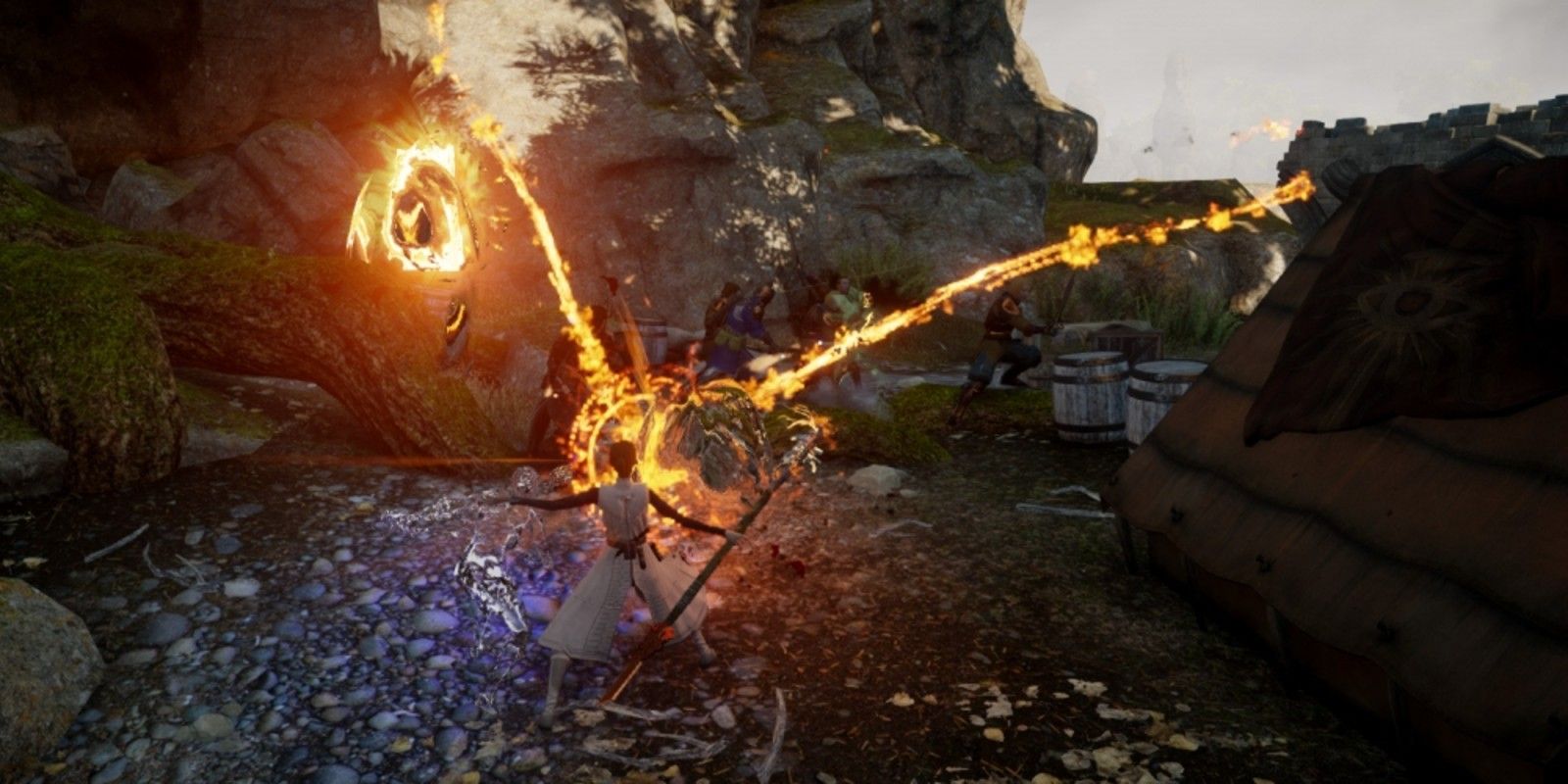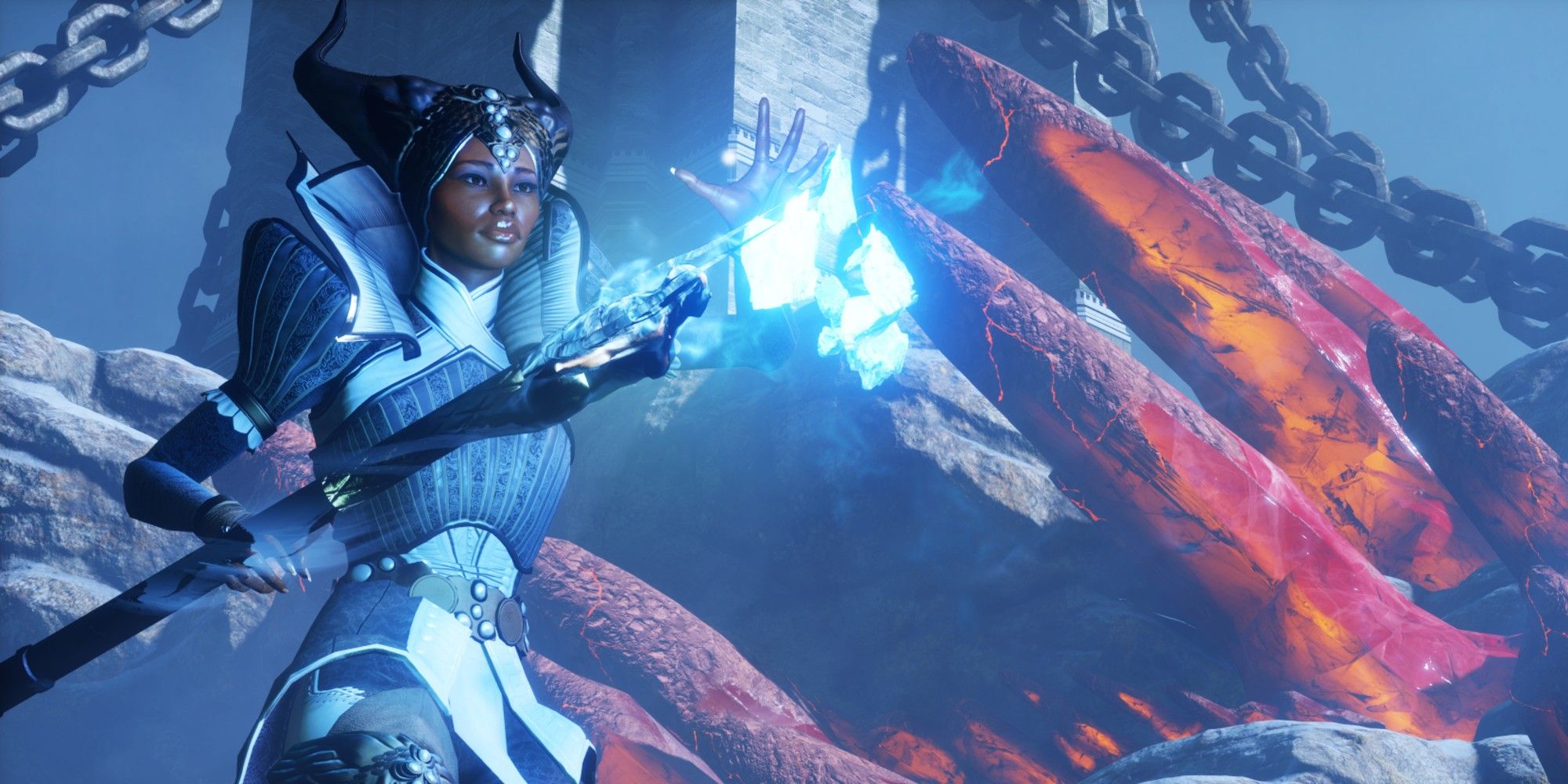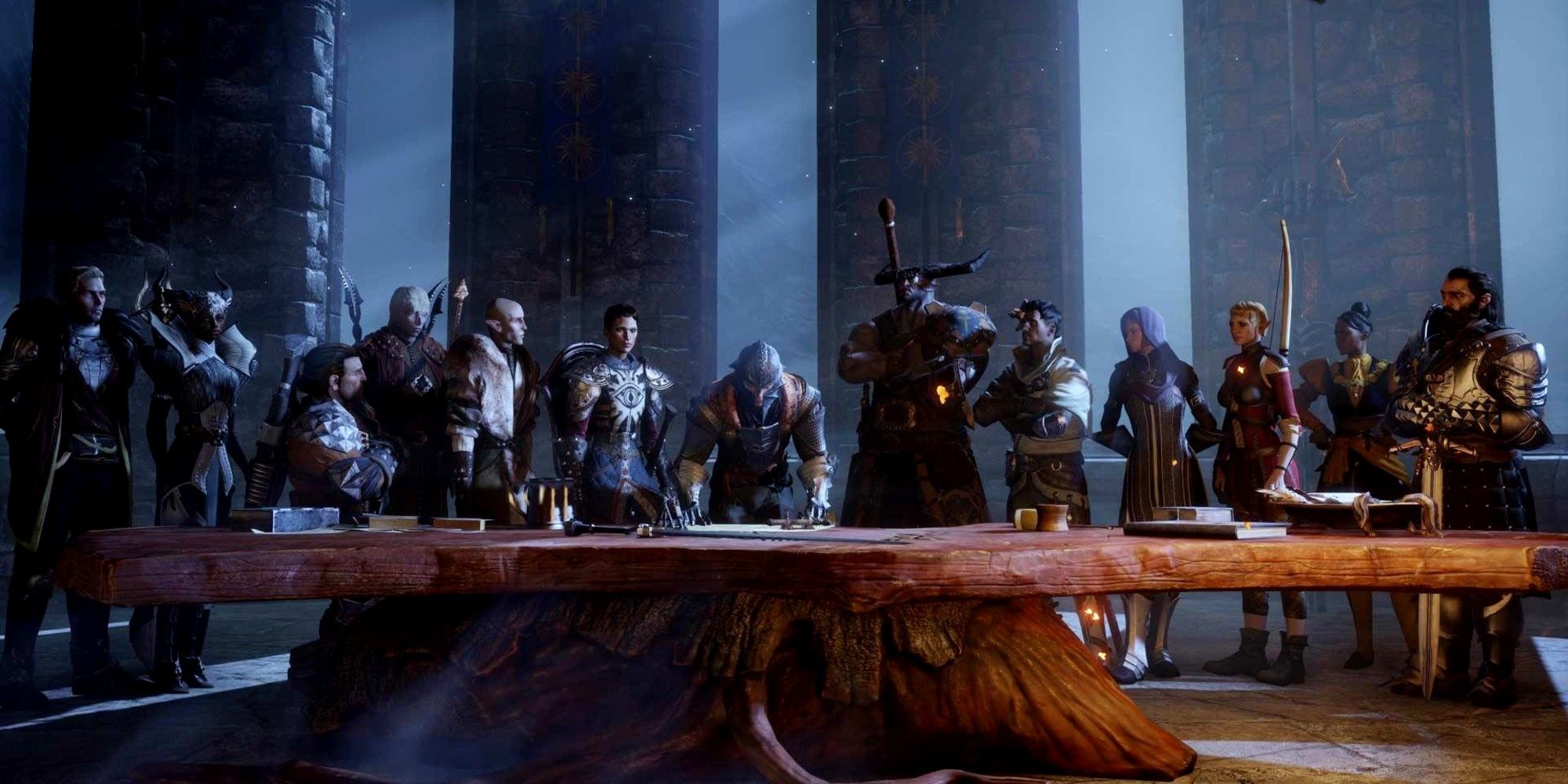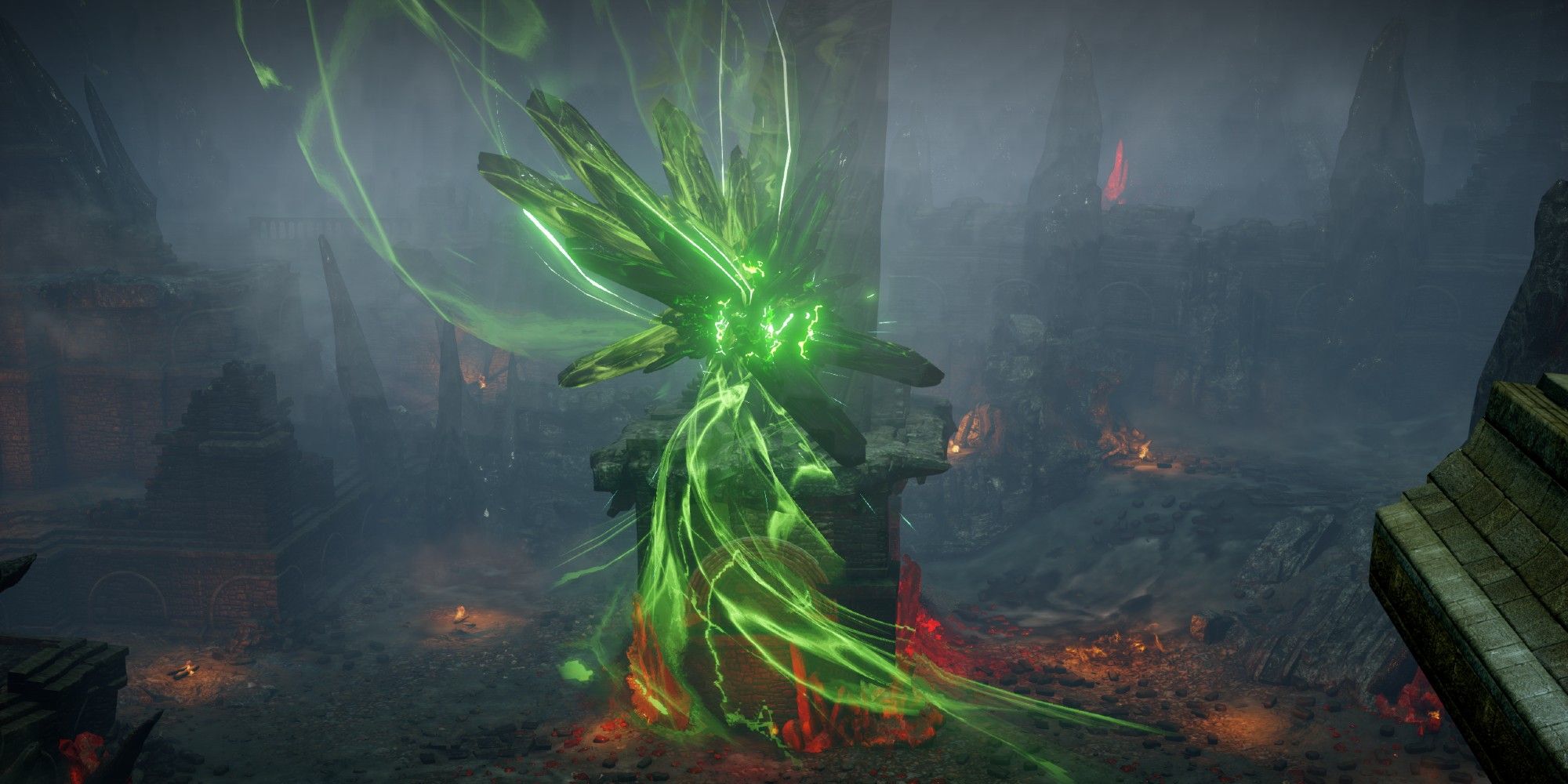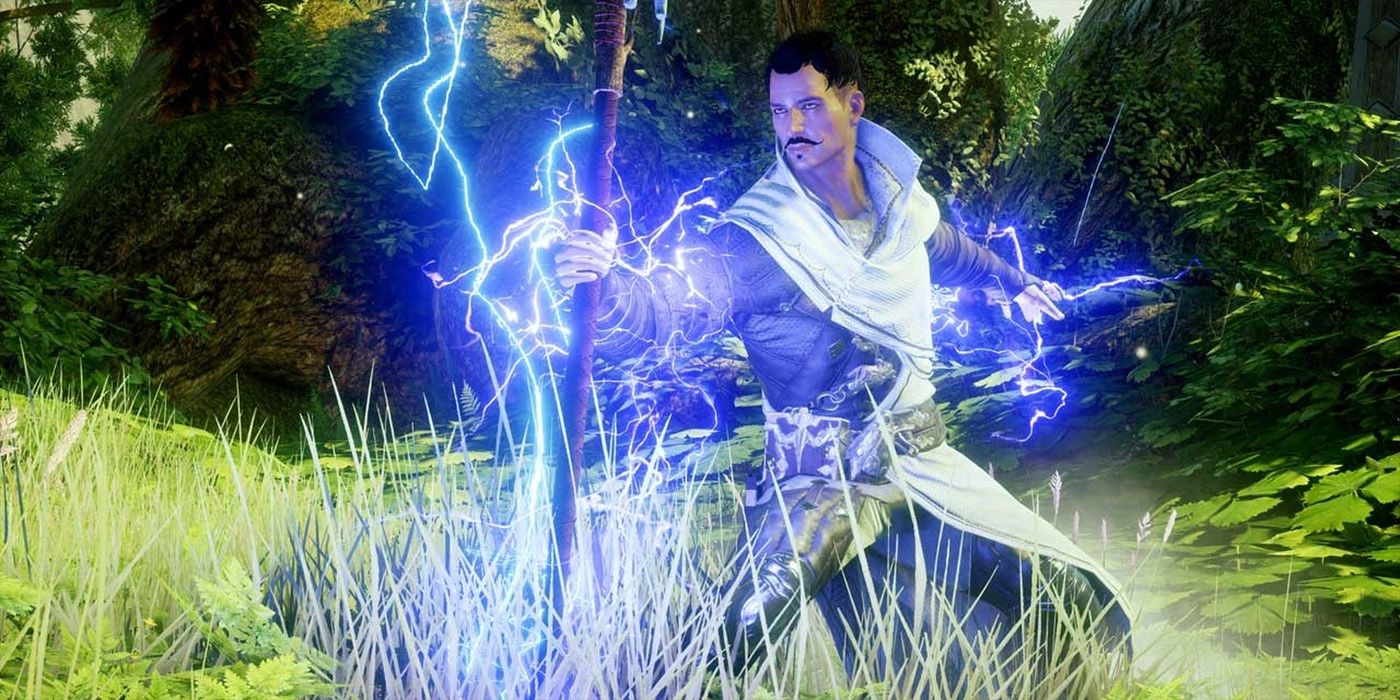Mages are an especially powerful class choice in Dragon Age: Inquisition and the three optional specializations the Inquisitor can learn will allow them to deal massive damage or exercise complete control over a fight. Mages play an essential role in the story of Dragon Age: Inquisition, and choosing the mage class for the Inquisitor can place them right in the center of the Mage/Templar conflict that colors the first half of the main campaign. A character of human, elf, or qunari descent can take the mage class, though dwarves cannot. At the start of the game, mages have access to four trees: Spirit, Winter, Inferno, and Storm. Each corresponds to a kind of elemental magic the mage Inquisitor can perform, in addition to their abilities granted by the mark on their hand.
Once the Inquisition reaches Skyhold, players can select a specialization for their mage. There are three: Knight-Enchanter, Rift Mage, and Necromancer. Knight-Enchanters can be both ranged and melee fighters, wielding a spirit blade that resembles a lightsaber. Rift Mages control the battle by controlling and manipulating the Fade, the world of dreams where mages derive their power. This works well with the Inquisitor's ability to seal rifts in the Fade using their mark. Necromancers are high damage-dealers who can reanimate the dead for a short time and strike fear in enemies. Each of the three mage companions has one of these specializations: Vivienne is a Knight-Enchanter, Solas is a Rift Mage, and Dorian Pavus is a Necromancer. Even if the player does not choose the mage class, they can build these characters to be an integral and deadly part of the party. Here are the three best mage builds in Dragon Age: Inquisition.
Best Knight-Enchanter Build in Dragon Age: Inquisition
The best Knight-Enchanter build relies on the use of Spirit Blade when it has a high charge value, usually seen over the character's skills bar. Once Spirit Blade has been discharged, players will need to rapidly build the charge back up again by using spells or the normal staff attack, so the build focuses on the abilities that will best facilitate this buildup. Knight-Enchanters are extremely difficult to kill due to the constant application of Barrier from Fade Shield, making them excellent all-around attackers.
The essential abilities for this build are:
Spirit
- Barrier
Storm
- Energy Barrage & Energy Bombardment (upgrade)
- Conductive Current
- Static Charge
- Static Cage & Lightning Cage (upgrade)
Inferno
- Immolate
- Flashpoint
- Pyromancer
- Clean Burn
- Chaotic Focus
- Fire Mine & Flaming Array (upgrade)
Winter
- Fade Step & Energizing Step (upgrade)
Knight Enchanter
- Spirit Blade & Amplified Blade (upgrade)
- Combat Clarity
- Fade Cloak
- Decloaking Blast
- Fade Shield
They can also take these optional skills if they have points to spare:
Spirit
- Guardian Spirit
- Peaceful Aura
- Rejuvenating Barrier
Storm
- Chain Lightning & either upgrade
- Stormbringer
Knight Enchanter
- Veiled Riposte
- Knight-Protector
- Resurgence
Players can choose to take the Resurgence Focus Ability for Vivienne and leave that one to keep Mark of the Rift for pure damage if they are playing a Knight-Enchanter Inquisitor.
Players will want to load their Skill Bar with Spirit Blade, Fade Step, Fire Mine, Energy Barrage, Static Cage, Fade Cloak, and Barrier. They can begin a fight by casting Barrier on the party. Then, they will want to do damage, particularly with Energy Barrage to build up Spirit Blade charges to 99 or close to that. They can use Fade Step to get in melee range and discharge Spirit Blade once to use all the built up charges. When the Barrier bar above the character's Health bar is full, use Fire Mine to take advantage of the bonus damage from Chaotic Focus.
The Blade of Tidarion is particularly useful for a Knight-Enchanter, as well as the Seer Staff and Razikale's Staff. Players can craft a blade and grip that use materials to improve critical chance and critical damage for best results.
Best Rift Mage Build in Dragon Age: Inquisition
Rift Mages are primarily control and support party members, but they can also deal a lot of AoE damage when paired with the Inferno and Winter trees. Players can combine control spells with elemental spells to create spell combos that do major damage as well. To use this build, players will need the following skills:
Spirit
- Barrier
Inferno
- Immolate & Wildfire (upgrade)
- Flashpoint
- Clean Burn
- Pyromancer
- Fire Mine & Flaming Array (upgrade)
Winter
- Fade Step & Energizing Step (upgrade)
- Winter Stillness
- Ice Mine & Chilling Array (upgrade)
- Ice Armor
Rift Mage
- Stonefist & Shatterstone (upgrade)
- Encircling Veil
- Veilstrike & Punching Down (upgrade)
- Restorative Veil
- Smothering Veil
- Twisting Veil
- Pull of the Abyss & Devouring Veil (upgrade)
If the Inquisitor is the Rift Mage, they should keep Mark of the Rift as their Focus Ability. If the player is using this build on Solas, they should also be sure to pick up Firestorm. In the skill bar, players should make sure to have Immolate, Fire Mine, Fade Step, Ice Mine, Stonefist, Veilstrike, Pull of the Abyss, and either Firestorm or Mark of the Rift.
To play using this build, players should begin a fight using Veilstrike to give warriors and dual-wield rogues time to take a few damaging shots. They can do the greatest amount of damage by casting Fire Mines, then using Pull of the Abyss to drag enemies into the mines. They can also use Pull of the Abyss to drag enemies closer, cast Ice Mine, and then use Stonefist to Shatter enemies. Because this build expends a lot of mana, players should make sure to use Fade Step to get out of melee trouble and regenerate mana quickly.
Any staff tends to do for this build, but players might want to craft gear that specifically generates guard on hit. They will often find themselves close to enemies to use Fire and Ice Mine, so more guard will always help. They will also want to use materials and masterworks that improve critical chance and critical damage.
The Ring of Doubt will be absolutely critical for this build, as it can help the Inquisitor take out one enemy at the very start of a fight. To use it, players will want to hit a target with Immolate. Then, they will need to retreat to shrink back to stealth. Once in stealth, they can cast Fire Mine with the Flaming Array upgrade if they have Trespasser installed. The first time an enemy touches a glyph will be an immediate critical hit. Then, Flashpoint will allow the next cast Flaming Array a second time right away.
Best Necromancer Build in Dragon Age: Inquisition
Necromancers are the undisputed high damage dealers of the mage class, though some in Thedas and even within the Inquisition's ranks struggle to see it as separate from the taboo Blood Magic. Necromancer skills tend to pair well with the Inferno tree due to the interplay between panic and horror and burning effects. It is also delightfully chaotic.
To use this build, players will need the following skills:
Spirit
- Barrier
- Peaceful Aura
- Dispel & Transmute Magic (upgrade)
Inferno
- Immolate & Wildfire (upgrade)
- Flashpoint
- Pyromancer
- Fire Mine & Flaming Array (upgrade)
- Clean Burn
- Wall of Fire & Wave of Flame (upgrade)
Winter
- Fade Step
Necromancer
- Horror & Terror (upgrade)
- Death Siphon
- Blinding Terror
- Power of the Dead
- Simulacrum
- Spirit Mark
- Walking Bomb & Virulent (upgrade)
Players have the option of picking up any of the Storm tree passives to increase their damage output without using excess mana. They can also add the Haste Focus Ability for Dorian or keep Mark of the Rift for their Inquisitor. Players can also pick up whichever upgrades they prefer for Spirit Mark when they have extra skill points. They can also pick up the upgrade Energizing Step for Fade Step once they have the core build set up, and Restorative Veil in Spirit to help mitigate mana loss.
Players should keep Fade Step, Walking Bomb, Spirit Mark, Fire Mine, Immolate, Dispel, and Wall of Fire active in their skill bar. If the Necromancer is their Inquisitor, Mark of the Rift will take the last slot. If it is Dorian, Haste or Horror will be the best fit.
To use this build, players should focus on using Fire Mine as their main spell. They can cast Spirit Mark and Walking Bomb near when an enemy is close to death to take advantage of their AoE effects against living enemies. They can use Horror and Wall of Fire together to panic enemies and make them more susceptible to damage as well. And, like with Rift Mage, Necromancers wearing the Ring of Doubt can take advantage of the automatic critical hit and no cooldown from casting immolate, retreating to stealth, and casting Fire Mine twice.
Players will want a staff with high DPS for this build, as well as gear that increases critical chance and critical damage. It is also a good idea to include a masterwork that includes a chance to use Horror or Walking Bomb on a hit.
Dragon Age: Inquisition is available for PC, PlayStation 4, and Xbox One.

